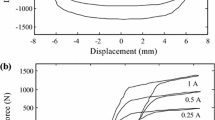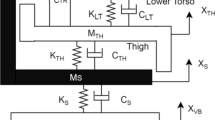Abstract
In this paper, the dynamic behavior of a non-linear eight degrees of freedom vehicle model having active suspensions and a fuzzy logic (FL) controlled passenger seat is examined. The non-linearity occurs due to dry friction on the dampers. Three cases of control strategies are taken into account. In the first case, only the passenger seat is controlled. In the second case, only the vehicle body is controlled. In the third case, both the vehicle body and the passenger seat are fully controlled at the same time. The time responses of the non-linear vehicle model due to road disturbance and the frequency responses are obtained for each control strategy. At the end, the performances of these strategies are compared.
Similar content being viewed by others
Abbreviations
- a, b:
-
distances of axle to the center of gravity of the vehicle body
- c, d:
-
distances of unsprung masses to the center of gravity of the axles
- e, f:
-
distances of passenger seat to the center of gravity of the vehicle body
- c si :
-
ith damping coefficient of suspension
- c s5 :
-
damping coefficient of passenger seat
- f(V ri ):
-
ith dry friction force
- k si :
-
ith spring constant of suspension
- k s5 :
-
spring constant of passenger seat
- k ti :
-
ith stiffness coefficient of tire
- m i :
-
ith mass of axle
- m 5 :
-
mass of the passenger
- x i :
-
ith state variable
- z i (t):
-
ith road excitation
- I x 7 :
-
mass moment of inertia of the vehicle body for pitch motion
- I x 8 :
-
mass moment of inertia of the vehicle body for roll motion
- M :
-
mass of the vehicle body
References
Redfield, R. C. and Karnopp, D. C., ‘Optimal performance of variable component suspensions’, Vehicle System Dynamics 17, 1988, 231–253.
Yue, C., Butsuen, T., and Hedrick, J. K., ‘Alternative control laws for automotive active suspensions’, Journal of Dynamic Systems, Measurement, and Control 111, 1989, 286–291.
Stein, G. J. and Ballo, I., ‘Active vibration control system for the driver’s seat for off-road vehicles’, Vehicle System Dynamics 20, 1991, 57–78.
Hac, A., ‘Optimal linear preview control of active vehicle suspension’, Vehicle System Dynamics 21, 1992, 167–195.
Rakheja, S., Afework, Y., and Sankar, S., ‘An analytical and experimental investigation of the driver-seat-suspension system’, Vehicle System Dynamics 23, 1994, 501–524.
Crolla, D. A. and Abdel Hady, M. B. A., ‘Active suspension control: Performance comparisons using control laws applied to a full car model’, Vehicle System Dynamics 20, 1991, 107–120.
Hrovat, D., ‘Applications of optimal control to advanced automotive suspension design’, Journal of Dynamic Systems, Measurement, and Control 115, 1993, 328–342.
Silvester, B. C., ‘Vibration reduction in motor cars’, Society of Environmental Engineers 4, 1966.
Alleyne, A., Neuhaus, P. D., and Hedrick, J. K., ‘Application of non-linear control theory to electronically controlled suspensions’, Vehicle System Dynamics 22, 1993, 309–320.
Yagiz, N. and Yuksek, I., ‘Sliding mode control of active suspensions for a full vehicle model’, International Journal of Vehicle Design 26(2/3), 2001, 264–276.
Park, J. H. and Kim, Y. S., ‘Decentralized variable structure control of vehicle active suspensions’, JSME International Journal, Mechanical Systems, Machine Elements and Manufacturing 43(1), 2000, 73–79.
Yokoyama, M., Hedrick, J. K., and Toyama, S., ‘A model following sliding mode controller for semi-active suspension systems with MR dampers’, in Proceedings of the American Control Conference, Arlington, VA, Vol. 4, June 25–27, 2001, pp. 2652–2657.
Yoshimura, T., Kume, A., Kurimoto, M., and Hino, J., ‘Construction of an active suspension system of a quarter car model using the concept of sliding mode control’, Journal of Sound and Vibration 239(2), 2001, 187–199.
Al-Holou, N., Lahdhiri, T., Joo, D. S., Weaver, J., and Al-Abbas, F., ‘Sliding mode neural network inference fuzzy logic control for active suspension systems’, IEEE Transactions on Fuzzy Systems 10(2), 2002, 234–246.
Baumal, A. E., McPhee, J. J., and Calamai, P. H., ‘Application of genetic algorithms to the design optimization of an active vehicle suspension system’, Computer Methods in Applied Mechanics and Engineering 163, 1998, 87–94.
Rao, M. V. C. and Prahlad, V., ‘A tunable fuzzy logic controller for vehicle-active suspension systems’, Fuzzy Sets and Systems 85(1), 1997, 11–21.
Zadeh, L., ‘Fuzzy sets’, Information and Control 8(3), 1965, 338–353.
Ross, T. J., Fuzzy Logic for Engineering Applications, McGraw-Hill, New York, 1995.
De Falco, D., Della Valle, S., and Riviezzo, E., ‘Motorcycle traction control system based on the fuzzy adjustment of target slip’, in Proceedings of the Second International Conference on Control and Diagnostics in Automotive Applications, CD AUTO98, Genoa, Italy, October 29–30, 1998, pp. 145–154.
Author information
Authors and Affiliations
Corresponding author
Rights and permissions
About this article
Cite this article
Guclu, R. Fuzzy Logic Control of Seat Vibrations of a Non-Linear Full Vehicle Model. Nonlinear Dyn 40, 21–34 (2005). https://doi.org/10.1007/s11071-005-3815-7
Received:
Accepted:
Issue Date:
DOI: https://doi.org/10.1007/s11071-005-3815-7




